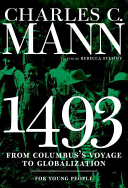2018 School Spending Survey Report
1493 for Young People: From Columbus's Voyage to Globalization
adapted by Rebecca Stefoff. 416p. chron. glossary. index. maps. photos. reprods. Seven Stories. Jan. 2016. Tr $40. ISBN 9781609806309; pap. $18.95. ISBN 9781609806637.
COPY ISBN
 Gr 7–10—Stefoff abridges and simplifies Mann's adult title 1493: Uncovering the New World Columbus Created (Knopf, 2011), objectively describing how European exploration and the resulting Columbian Exchange of plants, animals, and diseases rapidly made the world "global" in outlook and practice, with a mixed legacy of wealth and higher living standards, oppression, losses of entire populations, and environmental degradation. Both versions share format and topics and are not complete histories of global exploration and exchange. They instead focus on large and small factors, such as the failed Scottish colony in Panama, European earthworms in North America, and Africans' partial immunity to malaria, that had unexpected and significant effects on nations, agriculture, and the spread of slavery. Sections on often-overlooked and important topics such as the trans-Pacific trade that destabilized the Chinese government, the unexpected and enduring environmental and human costs of single-crop (potatoes) and industrial (rubber trees) agriculture, and the "crazy soup" of mixed population groups are informative and thought-provoking. Maps and large illustrations supplement the text. More detailed than Marc Aronson and John W. Glenn's The World Made New: Why the Age of Exploration Happened and How It Changed the World (National Geographic, 2007) and a good companion to Mann's Before Columbus: The Americas of 1491 (S. & S., 2009), this book will help students understand the origins and continuing consequences of the globalization that was the almost immediate result of European exploration and exploitation of the New World.
Gr 7–10—Stefoff abridges and simplifies Mann's adult title 1493: Uncovering the New World Columbus Created (Knopf, 2011), objectively describing how European exploration and the resulting Columbian Exchange of plants, animals, and diseases rapidly made the world "global" in outlook and practice, with a mixed legacy of wealth and higher living standards, oppression, losses of entire populations, and environmental degradation. Both versions share format and topics and are not complete histories of global exploration and exchange. They instead focus on large and small factors, such as the failed Scottish colony in Panama, European earthworms in North America, and Africans' partial immunity to malaria, that had unexpected and significant effects on nations, agriculture, and the spread of slavery. Sections on often-overlooked and important topics such as the trans-Pacific trade that destabilized the Chinese government, the unexpected and enduring environmental and human costs of single-crop (potatoes) and industrial (rubber trees) agriculture, and the "crazy soup" of mixed population groups are informative and thought-provoking. Maps and large illustrations supplement the text. More detailed than Marc Aronson and John W. Glenn's The World Made New: Why the Age of Exploration Happened and How It Changed the World (National Geographic, 2007) and a good companion to Mann's Before Columbus: The Americas of 1491 (S. & S., 2009), this book will help students understand the origins and continuing consequences of the globalization that was the almost immediate result of European exploration and exploitation of the New World.
VERDICT An excellent addition to history collections.
RELATED
ALREADY A SUBSCRIBER? LOG IN
We are currently offering this content for free. Sign up now to activate your personal profile, where you can save articles for future viewing




Be the first reader to comment.
Comment Policy:
Comment should not be empty !!!